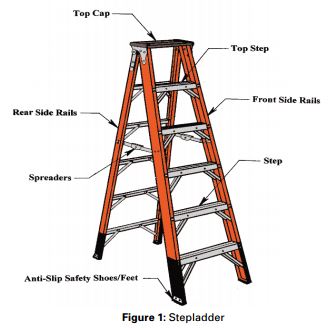At some point in our lives we will all encounter a job or project that will require us to perform a task that is out of ones reach. And as compelling as it may be – standing on a chair, boxes or table isn’t really the best idea. For those “out of reach” projects it’s always best to use a ladder. But with all tools, using the right ladder and using it properly is critical to your safety and well-being.
According to the Center for Disease Control and Prevention, falls remain a leading cause of unintentional injury nationwide, and 43% of fatal falls in the last decade have involved a ladder. That is why learning basic ladder safety is so important.
Although there are over 21 different types of rigid ladders, we are going to focus on one of the most commonly used in both household and job site applications – the Stepladder.
What is a Stepladder? A stepladder is a portable, self-supporting, A-frame ladder. It has two front side rails and two rear side rails. Generally, there are steps mounted between the front side rails and bracing between the rear side rails.
Not all Stepladders are Created Equally: Even though the stepladder can be used for all types of jobs big and small, the key is to make sure you have the right stepladder for the job and that includes ensuring you have the proper load capacity. The basic guideline in determining the proper load capacity is to use a ladder that can sustain at least four times the maximum intended load. To determine the correct ladder, consider your weight plus the weight of your load. Do not exceed the load rating and always include the weight of all tools, materials and equipment.
Stepladder Safety: Whether you are a homeowner or a business owner, it’s your responsibility to train your family and employees to recognize and minimize ladder-related hazards. Look for these common ladder hazards before you take your first step up and avoid injuries:
10 Common Stepladder Hazards to Avoid
- Inspect your ladder before using; don’t use a ladder that has missing or loose pieces/parts
- Never set-up a ladder on slippery or unstable surface
- Moving or shifting a ladder with a person or equipment on the ladder
- Check to make sure the ladder spreaders are locked
- Never stand on the top step or top cap
- Don’t load your ladder beyond the rated load capacity rating
- Avoid setting up your ladder in high-traffic locations
- Don’t reach outside ladder side rails
- Never, ever set-up or use a ladder that is in close proximity to electrical wiring/equipment
- Use ladders for a purpose other than that for which they were designed. For example, do not use a folded stepladder as a single ladder
At Sparkle Wash, we believe our employees’ and customers’ safety is a top priority. And that’s why all our pressure washing technicians participate in on-going safety training and testing. We pride ourselves in delivering the best power washing service in our area, with a safety record to match. Please let us know if you would like to learn more about our Commercial, Residential and Fleet Pressure Washing services


Recent Comments